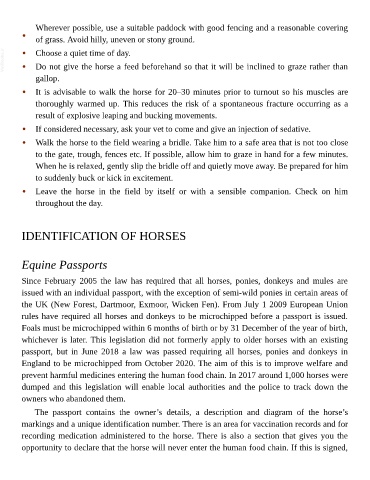Page 1115 - The Veterinary Care of the Horse
P. 1115
Wherever possible, use a suitable paddock with good fencing and a reasonable covering
• of grass. Avoid hilly, uneven or stony ground.
VetBooks.ir • Choose a quiet time of day.
•
Do not give the horse a feed beforehand so that it will be inclined to graze rather than
gallop.
• It is advisable to walk the horse for 20–30 minutes prior to turnout so his muscles are
thoroughly warmed up. This reduces the risk of a spontaneous fracture occurring as a
result of explosive leaping and bucking movements.
• If considered necessary, ask your vet to come and give an injection of sedative.
• Walk the horse to the field wearing a bridle. Take him to a safe area that is not too close
to the gate, trough, fences etc. If possible, allow him to graze in hand for a few minutes.
When he is relaxed, gently slip the bridle off and quietly move away. Be prepared for him
to suddenly buck or kick in excitement.
• Leave the horse in the field by itself or with a sensible companion. Check on him
throughout the day.
IDENTIFICATION OF HORSES
Equine Passports
Since February 2005 the law has required that all horses, ponies, donkeys and mules are
issued with an individual passport, with the exception of semi-wild ponies in certain areas of
the UK (New Forest, Dartmoor, Exmoor, Wicken Fen). From July 1 2009 European Union
rules have required all horses and donkeys to be microchipped before a passport is issued.
Foals must be microchipped within 6 months of birth or by 31 December of the year of birth,
whichever is later. This legislation did not formerly apply to older horses with an existing
passport, but in June 2018 a law was passed requiring all horses, ponies and donkeys in
England to be microchipped from October 2020. The aim of this is to improve welfare and
prevent harmful medicines entering the human food chain. In 2017 around 1,000 horses were
dumped and this legislation will enable local authorities and the police to track down the
owners who abandoned them.
The passport contains the owner’s details, a description and diagram of the horse’s
markings and a unique identification number. There is an area for vaccination records and for
recording medication administered to the horse. There is also a section that gives you the
opportunity to declare that the horse will never enter the human food chain. If this is signed,

